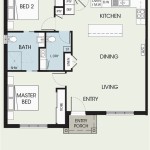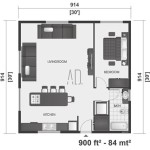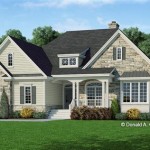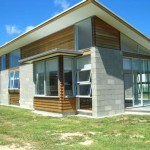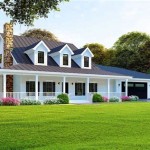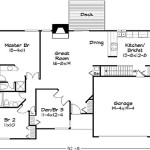Small Home Plans: Maximizing Comfort in 1000 Sq Ft
The allure of homeownership is often intertwined with images of sprawling estates and expansive layouts. However, the reality for many, particularly first-time buyers and those seeking to downsize, often involves navigating the world of smaller homes. Among the various sizes, a 1000 sq ft home plan presents a unique opportunity to balance affordability, maintainability, and comfortable living. This article aims to explore the key considerations and design strategies involved in creating functional and aesthetically pleasing living spaces within a 1000 sq ft footprint.
Many factors contribute to the growing appeal of smaller homes. Rising construction costs, increasing land prices, and a growing awareness of environmental sustainability all play a role. A smaller home requires less material to build, resulting in lower construction expenses. Furthermore, smaller homes typically consume less energy for heating and cooling, translating to reduced utility bills and a smaller carbon footprint. For individuals or couples seeking a minimalist lifestyle, a 1000 sq ft home provides a manageable space that encourages mindful living and reduces clutter.
Designing a successful 1000 sq ft home requires careful planning and attention to detail. Every square inch must be utilized efficiently to maximize functionality and create a comfortable living environment. Open floor plans, strategic storage solutions, and multi-functional spaces are essential components of a well-designed small home. The selection of appropriate building materials and design styles can also contribute to the overall aesthetic and feel of the space.
Optimizing Space with Open Floor Plans
One of the most effective strategies for maximizing space in a 1000 sq ft home is the adoption of an open floor plan. This design concept eliminates or minimizes walls between the living room, dining room, and kitchen, creating a larger, more unified space that feels less cramped. By removing visual barriers, natural light can penetrate deeper into the home, further enhancing the sense of spaciousness.
Open floor plans facilitate a more fluid flow of movement and encourage social interaction. The kitchen, often considered the heart of the home, becomes an integral part of the living space, allowing for seamless interaction between those preparing meals and those relaxing or entertaining. This design also allows for greater flexibility in furniture placement and arrangement, adapting to the evolving needs of the homeowner.
Consider the placement of the kitchen within the open floor plan. An island or peninsula can serve as a natural divider between the kitchen and living areas, providing additional counter space and seating. Strategic placement of furniture can also help to define distinct zones within the open space without the need for physical walls. Rugs, lighting fixtures, and changes in flooring can all be used to visually separate different areas.
Another key consideration is storage. In an open floor plan, it is crucial to incorporate ample storage solutions to prevent clutter from accumulating and detracting from the overall aesthetic. Built-in shelving, hidden storage compartments, and strategically placed cabinets can help to keep the space organized and visually appealing.
The effective implementation of an open floor plan in a 1000 sq ft home requires careful consideration of furniture scale and layout. Overly large furniture can overwhelm the space and make it feel smaller. Opting for smaller, multi-functional pieces, such as a sofa bed or a dining table that can be extended, can help to maximize space and functionality.
Strategic Storage Solutions for Small Spaces
Adequate storage is paramount in any home, but it becomes particularly crucial in a smaller space like a 1000 sq ft home. Clever storage solutions help to minimize clutter, maximize usable space, and create a more organized and livable environment. Utilizing vertical space, incorporating multi-functional furniture, and thinking outside the box are all key strategies for maximizing storage in a small home.
One of the most effective ways to maximize storage is to utilize vertical space. Tall bookshelves, floor-to-ceiling cabinets, and wall-mounted shelves can provide ample storage without taking up valuable floor space. Consider installing shelves above doorways or in hallways to create additional storage areas. In the kitchen, utilize the space up to the ceiling for cabinet storage.
Multi-functional furniture is another valuable tool for maximizing storage in a small home. Sofa beds provide sleeping space for guests without requiring a dedicated guest room. Coffee tables with built-in storage compartments can hide away blankets, pillows, and other items. Ottomans with removable lids can be used for seating and storage. Beds with drawers underneath provide convenient storage for clothing, linens, or other items.
Thinking outside the box is also essential for maximizing storage in a small home. Consider using the space under the stairs for storage. Install hooks on the back of doors to hang coats, bags, or towels. Use clear plastic bins to organize items in closets and cabinets. Employ wall-mounted organizers for storing tools, spices, or other small items.
Built-in storage solutions can also be highly effective. Built-in bookshelves, cabinets, and benches can be customized to fit the specific dimensions of the home and provide tailored storage solutions. These built-in features can also add architectural interest and character to the space.
Regular decluttering is an essential component of maintaining an organized small home. Take the time to regularly sort through belongings and donate or discard items that are no longer needed or used. This will help to prevent clutter from accumulating and keep the space feeling open and organized.
Designing for Multifunctionality
In a 1000 sq ft home, the ability to adapt spaces for multiple purposes is essential. Designing for multifunctionality maximizes the utility of each room, ensuring that the home meets a variety of needs without feeling cramped or cluttered. This involves considering how each space can be used at different times of the day or for different activities, and selecting furniture and design elements that support these multiple functions.
The living room can often serve as a home office, entertainment center, and guest room. A comfortable sofa bed can easily transform the living room into a guest room. A well-organized entertainment center can house a television, sound system, and other electronic devices, while also providing storage for books and games. A desk or table can be set up in a corner of the living room to create a dedicated workspace.
The kitchen can also serve as a dining area and home office. A kitchen island or peninsula can provide ample counter space for food preparation and can also be used as a dining table. A small table and chairs can be placed in a corner of the kitchen to create a cozy dining nook. A laptop and workspace can be set up on the kitchen counter for quick work tasks.
The bedroom can serve as a dressing room, reading nook, and relaxation space. A well-organized closet can provide ample storage for clothing and accessories. A comfortable armchair and reading lamp can create a cozy reading nook. A yoga mat can be placed on the floor for morning stretches or meditation.
Consider furniture that can be easily moved or reconfigured to adapt to different needs. Folding tables, stackable chairs, and modular furniture can all be used to create flexible spaces. A room divider can be used to create temporary privacy or to separate different zones within a room.
Lighting plays a crucial role in creating multi-functional spaces. Adjustable lighting fixtures can be used to create different moods and to highlight different areas of the room. Task lighting can be used for focused work, while ambient lighting can be used for relaxation. Dimmable lights can be used to create a variety of lighting effects.
By carefully considering the needs of the homeowner and designing spaces that can be adapted for multiple purposes, it is possible to create a comfortable and functional living environment within a 1000 sq ft home.
These design considerations aim to demonstrate the possibilities within a limited square footage. A well-planned 1000 sq ft home can be both comfortable and efficient.

7 Ideal Small House Floor Plans Under 1 000 Square Feet

Our Top 1 000 Sq Ft House Plans Houseplans Blog Com

House Plans Under 1000 Square Feet

Our Top 1 000 Sq Ft House Plans Houseplans Blog Com

Small House Plans Under 1000 Sqft Craft Mart

Open Concept 1 000 Sq Ft House Plans With 2 Bedrooms Blog Builderhouseplans Com

Open Concept 1 000 Sq Ft House Plans With 2 Bedrooms Blog Builderhouseplans Com

Three Low Budget 1000 Sq Ft Bedroom House Plans For 120 Yard 3 Cent Plots

Small House Plans Under 1000 Sqft Craft Mart

Tiny House Plans And Small 1 Story Below 1000 Sq Ft

